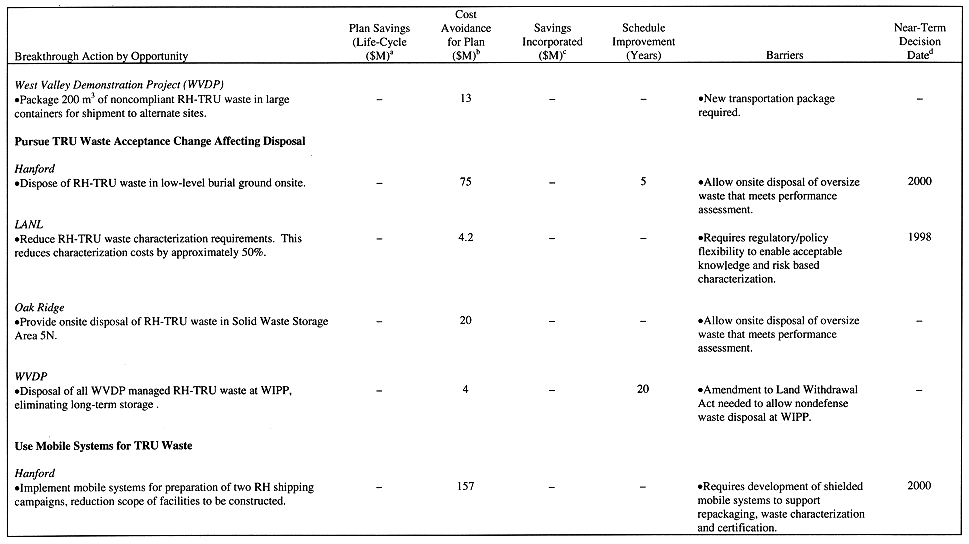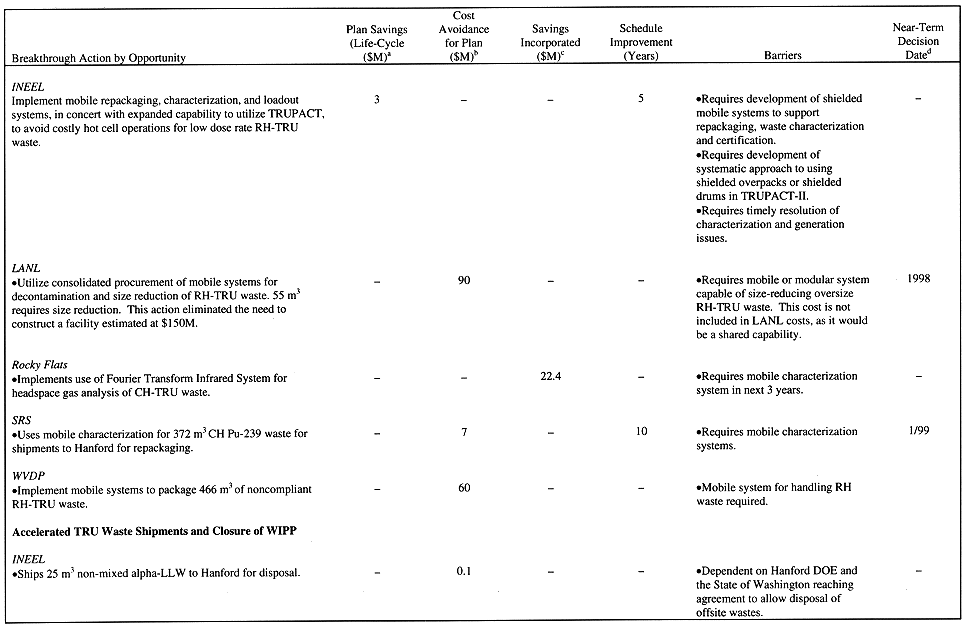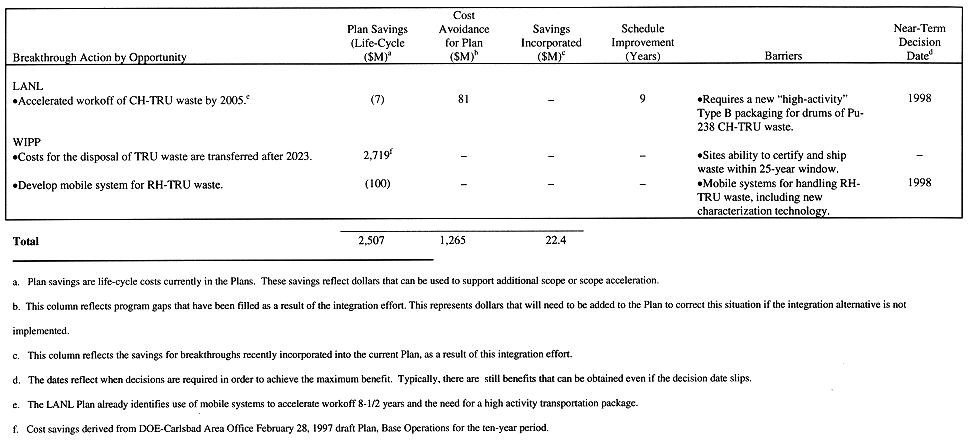
DEVELOPMENT OF AN INTEGRATED STRATEGY FOR
COMPLEX-WIDE ACCELERATION AND OPTIMIZATION OF
TRANSURANIC WASTE DISPOSITION
Brent Daugherty
SRS
Kenneth Hladek
Hanford
Frank Votaw, Tom Clements and Michael Martin
INEEL
Stanley Kosiewicz and Edward Derr
LANL
Michael Griffin and Thomas Monk
ORNL
Jerry O’Leary
Rocky Flats
Joseph Jones, Andrew Orrell and Jack Tillman
SANDIA
Phil Gregory
WIPP
Jeffery Choroser
WVDP
ABSTRACT
An Environmental Management Integration (EMI) team was convened in July of 1996, at the request of the Assistant Secretary for Environmental Management, to identify opportunities for acceleration and enhancement of the complex-wide Transuranic (TRU) waste program. A team, comprised of operating contractors from 10 large Department of Energy (DOE) sites, was tasked to provide recommendations for improving the complex’s ability to safely treat, store and dispose of all the Department’s TRU waste. This set of recommendations was developed through sharing of resources (e.g. ideas, facilities, and site expertise) with the goals of reducing costs, accelerating existing schedules and providing the necessary capabilities to achieve final disposition of all TRU waste.
This TRU waste team approached the challenge by developing a three-tier program. First, a set of top level priority enabling actions were identified to establish the boundaries within which the team would work to improve the baseline TRU program. These actions included expansion of the current transportation capability, use of mobile systems for characterization and processing, and consolidation of waste at large sites. They form the basis for an integrated solution to successfully disposition all TRU waste. Second, four sets of alternatives were developed for Contacted Handled TRU (CH-TRU) and two sets for Remote Handled TRU (RH-TRU) which identify different approaches to achieving complex-wide integration. From these sets of alternatives, preferred alternatives were chosen as representing the best set of opportunities to enhance the program. Third, each site identified specific "breakthrough actions" which support the preferred alternatives. The breakthrough actions have the potential to save the complex an estimated combined life cycle cost savings and cost avoidance of $3.3 billion dollars and to reduce the overall schedule for TRU waste disposal by approximately 10 years.
INTRODUCTION
The Environmental Management Integration (EMI) team concept was developed and sponsored by the Assistant Secretary for Environmental Management and was chartered to identify opportunities for implementing DOE-EM’s 10 Year Vision through complex-wide integration in an effort to reduce DOE-EM program costs and risks. This process utilized contractor staff from multiple DOE facilities in the most important waste stream areas to systematically develop technically defensible recommendations, which would reduce costs and accelerate schedules without additional risks. Each waste team worked independently to develop its recommendations for integrating the complex (although cross waste stream integration effects were eventually included). It should be recognized that a number of the recommendations proposed in the TRU Team’s report were already included in the National TRU Program’s baseline for dispositioning TRU waste at the Waste Isolation Pilot Plant (WIPP). Due to the importance of presenting a total picture, these activities were included. The fact that these needs were independently arrived, at using a systematic approach, validates their importance to the success of the overall TRU program.
DISCUSSION
The TRU Waste Team identified the three following bounding system actions which link together to form the basis for the development of a preferred alternative program. These are:
These priority enabling actions are all necessary to build a comprehensive plan for dispositioning TRU wastes. The expansion of the transportation system provides the ability to move TRU wastes from sites without processing capability (primarily SQSs) to sites with larger inventories, where it is cost effective to process TRU wastes. To transport these wastes, both to other sites and to WIPP if applicable, waste characterization is required, thus generating the need for mobile systems for characterization as well as sorting, segregating, and other waste handling needs. Larger sites with specific capability and expertise must accept wastes from other sites for processing to consolidate inventories.
To support the priority enabling actions, the TRU waste integration team developed alternatives for both (CH) and (RH) TRU waste, and these alternatives were evaluated against a set of criteria developed by the integration team. These criteria included: the potential for cost reduction, life cycle schedule improvement, speed of implementation, stakeholder acceptance, site consensus, risk reduction, confidence level and degree of difficulty. From this evaluation, the preferred alternatives were chosen.
In the case of CH-TRU waste, four sets of alternatives were identified:
Alternative A:
Current requirements as identified in the National TRU Waste Management Plan (DOE/NTP-96-1024) for management of CH-TRU contaminated wastes are implemented. Intersite cooperation is employed to improve cost effectiveness and avoid duplicate facilities and capabilities. Disposition of substantially all DOE complex CH-TRU contaminated wastes, considered in this evaluation, is achieved.
Alternative B:
Generally similar to Alternative A in implementing current requirements, but also implements use of other DOT-compliant shipping containers (ATMX, Super Tiger etc.) for both intersite consolidation/disposal/preparation and shipments to WIPP. Disposition of substantially all DOE complex CH-TRU contaminated wastes, considered in this evalation, is achieved.
Alternative C:
Extensive regulatory changes are implemented requiring significant stakeholder input and support. Results of additional WIPP performance assessments are assumed to demonstrate that hazardous and toxic constituents are not a regulatory concern and that current levels of waste characterization can be reduced or eliminated. Additionally, the definition of wastes allowed for disposal at WIPP is expanded to include certain wastes historically managed as TRU waste. Therefore, waste characterization is performed only to the extent necessary to meet transportation and safe-handling requirements at WIPP. Disposition of all DOE complex CH-TRU wastes, considered in this evaluation, is achieved.
Alternative D:
This alternative includes, as determined by the TRU team, the best elements from Alternatives A, B and C and provides for phased development and implementation.
Defined as the Preferred Case, Alternative D provides medium confidence in achieving success with a potential for significant cost avoidance over the life cycle of dispositioning TRU wastes. The principal result is a more cost-effective, less-restrictive transportation system. Phase I implements current requirements and incorporates the additional recommendations identified below for implementation in the near term, to achieve improved schedule and cost effectiveness. Phase II involves additional technical evaluation and reassessment of regulatory requirements, and when appropriate, initiates activities requiring stakeholder involvement prior to implementation. Disposition of substantially all DOE complex CH-TRU wastes, considered in this evaluation, is achieved.
The detailed breakdown of activities is as follows:
Phase I of Preferred Alternative
Consolidating TRU waste at large sites by:
Expanding capability of existing transport packages (TRUPACT II) by:
Phase II of Preferred Alternative
Consolidating TRU waste at large sites by:
Expanding capability of existing transport packages to:
Developing new transport packages to:
Pursuing regulatory changes affecting disposal:
In the case of RH-TRU waste, two alternative cases were identified:
Alternative A
Substantially all RH-TRU waste is dispositioned including non-defense TRU wastes managed by DOE (e.g. West Valley wastes). Intersite cooperation and use of mobile system capabilities are employed to improve cost effectiveness and avoid duplicating the construction of fixed facilities. Regulatory and institutional pushback is minimal. Additional innovative solutions are identified as a result of cross waste stream integration.
Alternative B
Generally similar to Alternative A, but provides the additional ability to potentially dispose of some RH-TRU waste on the generator storage sites based on performance assessments. In addition, the alternative increases regulatory and institutional flexibility by the modification of characterization requirements.
As does Alternative A, this alternative incorporates technically realistic solutions, but as with CH-TRU waste, it has an escalating degree of relief from institutional and regulatory requirements and requires technology development. Unlike CH-TRU waste, however, development of an alternative which achieves disposition of substantially all the RH-TRU waste within the framework of current regulatory/policy requirements was not possible. Therefore, both alternatives included at least some changes to regulatory/policy. Both alternatives are technically defensible, disposition substantially all DOE-managed RH-TRU waste and continue to provide adequate levels of environmental health and safety protection. Alternative B was chosen since it represents a more optimized approach to the disposition of RH-TRU waste.
The detailed breakdown of activities is as follows:
Phase I of Preferred alternative
Improving/expanding capability of existing transportation system by:
Consolidating RH-TRU waste as appropriate by:
Developing and deploying capabilities for characterization, preparation, and treatment by:
Pursuing policy changes to:
Phase II of Preferred Alternative
Pursuing regulatory changes affecting disposal at WIPP to:
In order to fully understand the magnitude of the above recommendations made by the EMI Team, each site identified what were termed as "breakthrough actions" which would result in real work at each site and provided an estimate for the potential cost savings and acceleration of schedules. This list of breakthrough actions is presented in Table I. It identifies each site’s activities, Ten Year Plan savings, cost avoidance dollars and any schedule improvement in dispositioning TRU wastes. It also identifies potential barriers to success. The largest potential savings identified arises from the disposition of all TRU waste at WIPP by 2023 resulting in a life cycle cost savings to the TRU program of ~$2.7B. Improving the transportation capability provides a combined cost savings and cost avoidance of ~$442M (complex rollup number) with Savannah River contributing ~$457M (represents the site contribution to the complex-wide rollup number which combines savings with additional expenditures) to the combined total as a result of not building thermal treatment capability for high activity Pu 238 wastes. Consolidating waste at larger sites results in another potential $217M in combined cost savings and cost avoidance. The use of mobile systems for waste characterization, sorting, segregating and repackaging results in an additional ~$317M in combined cost savings and cost avoidance. Finally, pursuing TRU Waste Acceptance Criteria changes affecting disposal provides another potential $103M in savings and cost avoidance.
Note: Cost savings numbers reflected above are rough order of magnitude estimates. Detailed cost estimates will be conducted on those actions which are accepted for further evaluation and inclusion into the Accelerated Cleanup Plan (ACP).
Table I.TRU Waste Integration Benefits and Site-Specific Barriers.






a. Plan savings are life-cycle costs currently in the Plans. These savings reflect dollars that can be used to support additional scope or scope acceleration.
b. This column reflects program gaps that have been filled as a result of the integration effort. This represents dollars that will need to be added to the Plan to correct this situation if the integration alternative is not implemented.
c. This column reflects the savings for breakthroughs recently incorporated into the current Plan, as a result of this integration effort.
d. The dates reflect when decisions are required in order to achieve the maximum benefit. Typically, there are still benefits that can be obtained even if the decision date slips.
e. The LANL Plan already identifies use of mobile systems to accelerate workoff 8-1/2 years and the need for a high activity transportation package.
f. Cost savings derived from DOE-Carlsbad Area Office February 28, 1997 draft Plan, Base Operations for the ten-year period.
CONCLUSIONS
The preferred alternatives developed by the EMI Team for CH-TRU and RH-TRU wastes encompass programmatic and technical approaches which are capable of dispositioning essentially all DOE defense TRU waste by 2023, allowing the Waste Isolation Pilot Plant (WIPP) costs to transfer to other future missions. Implementation of the preferred alternatives could lead to a potential savings of $2.5B and resolve waste disposition issues not otherwise addressed in the draft submittal of the Accelerated Cleanup Plan. These identified opportunities also avoid additional future costs (cost avoidance), estimated at $1.2B.
The EM Integration effort provides primarily technical recommendations for dispositioning TRU wastes across the complex. The effort has resulted in a list of opportunities presented to the Department of Energy for consideration and inclusion into the Department’s planning process, The Draft Accelerated Cleanup (ACP), Focus on 2006 issued in June 1997. The list of recommendations was provided to the stakeholders for review and comment, during their review, individual site stakeholders will be briefed on the corresponding breakthrough actions at each site and shown how each breakthrough action is aligned with the requirements identified in the ACP. The Department will consider stakeholder inputs from both the local and national perspective and incorporate their comments into the decision making process when drafting the final revision to the ACP.
REFERENCES
BACK